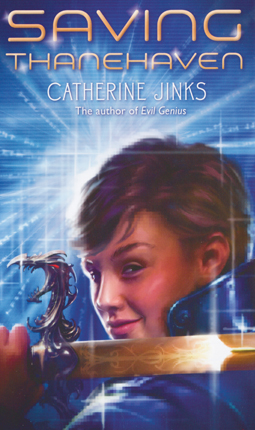| Saving Thanehaven Author: Jinks, Catherine | ||
| Price: $6.50 | ||
Summary:
Set in a computer game, a knight is swayed away from the game's rules by the promise of winning the affections of a princess and ending his life of torment.![]() Download a Teacher's Guide
Download a Teacher's Guide
| Accelerated Reader Information: Interest Level: MG Reading Level: 4.60 Points: 12.0 Quiz: 159827 | Reading Counts Information: Interest Level: 6-8 Reading Level: 4.20 Points: 19.0 Quiz: 61612 | |
Reviews:
Kirkus Reviews (05/15/13)
School Library Journal (08/01/13)
Booklist (07/01/13)
The Bulletin of the Center for Children's Books (A) (09/13)
Full Text Reviews:
Booklist - 07/01/2013 Long-suffering hero Noble is squelching through a carnivorous swamp on his way to rescue the princess or die trying, until he meets Rufus, an out-of-place kid who suggests that Noble’s life sucks. Noble privately agrees, but what else can he do? Stop? Well, yes: Rufus explains that Noble is trapped inside a computer game, and unless he takes back his autonomy from the players controlling him, he will never be free. Electrified by this revolutionary idea, Noble joins Rufus on a new quest to free others from this tyrannical system. As they travel within the computer, their subversive influence grows, but when the system fails, it looks more like chaos than freedom. Jinks cleverly reinterprets the inner workings of our familiar devices to create a believable computer world, though tech-savvy readers will appreciate it the most. Clues to Rufus’ true identity as a virus and what’s happening outside the computer are easily found, and the ultimate message—that following rules and thinking autonomously are not mutually exclusive—doesn’t feel didactic. This is a no-brainer for gamers. - Copyright 2013 Booklist.
School Library Journal - 08/01/2013 Gr 5–8—Noble's life is one of struggle and battle. He must fight everything he encounters, including the terrain he stands on, in his quest to reach the castle and free the princess. Even his own morphing weapon, Smite, can't be trusted. This all changes when Noble encounters Rufus, whose refreshing independent philosophy offers him a choice to leave behind his life of violent drudgery. Noble's quest is then transformed into one of liberation, as he in turn offers the individuals he encounters on his way the freedom to change their destinies. The only thing is, it turns out that Noble and his band of freedom seekers are in fact characters in computer games-and Rufus is a computer virus sent by the ostracized and disgruntled ex-friend of Mikey, the boy who owns the computer. Eventually Noble realizes that Rufus's only agenda is to force Noble's computer home to crash. With the support of his ragtag bunch of gaming heroes, Noble forces a showdown with Rufus. Jinks creates a hilarious combination of disparate game characters from Noble the Knight to zombies, MyScene-type fashion victims, and Lulu the silver unicorn from a preschool game. Their attempts at cooperation outside their individual game environments provide a very funny background to an overall theme of "is there capacity for independent thought in software and gaming programming?" As in Terry Pratchett's Only You Can Save Mankind (HarperCollins, 2004), readers are left with sympathy for the characters in the games, who are doomed to inevitable extinction as each new level is achieved. Jinks successfully delivers life lessons from gaming, and has a lot of fun along the way.—Jane Barrer, United Nations International School, New York City - Copyright 2013 Publishers Weekly, Library Journal and/or School Library Journal used with permission.
Bulletin for the Center... - 09/01/2013 Noble the Slayer is yet again slogging through treacherous terrain in the great kingdom of Thanehaven when a scrawny kid named Rufus shows up and informs him that Noble could be in charge of his own destiny if he helps Rufus take down something called the operating system. Tired of blood and mayhem, Noble follows Rufus on what he believes to be an honorable quest-freeing other people (or unicorns, in one instance) trapped in other “programs,” as Rufus refers to them. Each time he saves someone, though, the world becomes more unstable, resulting in the violent chaos that Noble was trying to stave off. Brief glimpses into the world outside the computer screen clue readers into what’s going on: in the real world, Rufus has gotten mad at his best pal Mikey and has infected his computer with malware. The intriguing premise certainly makes for some amusing and imaginative scenarios, as when Noble meets a clothes-obsessed trio from Mikey’s sister’s fashion game, but it also backs the characters into a corner. Noble and his accrued set of virtual pals are by their very nature one-note, which makes it difficult to invest in the fight for independence that Noble eventually takes up as his own. The breakneck pace, with characters jumping from one game and even computer to another, may nonetheless compel readers, and gamers will be particularly pleased with a few jargon-based jokes, so it may be worth keeping this on hand for gaming night. KQG - Copyright 2013 The Board of Trustees of the University of Illinois.



